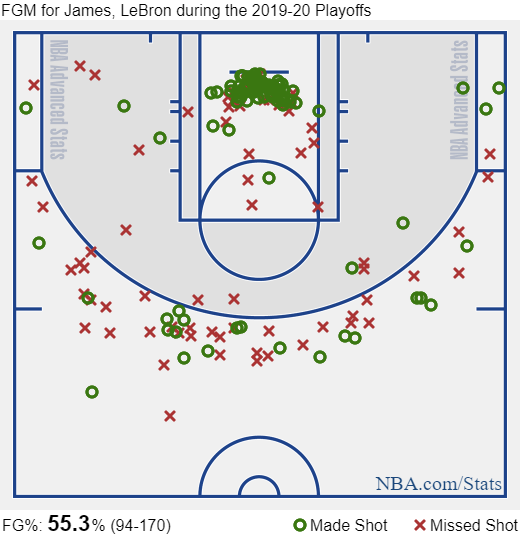
It was just over 18 months ago now that LeBron James received skeptical looks and, in some circles, outright jeers. He was coming off a badly pulled groin on Christmas day that kept him out 17 games and looking to course-correct the Lakers back into the playoff hunt in his first season with the team. He told everyone that the time was now, that he was going to “activate” playoff LeBron. The intensity and focus would be ramped up and he was, presumably, going to lead the team to the postseason.
That, of course, did not happen.
In the 15 games following LeBron’s comments to the media, the Lakers went 4-11. They had several disappointing losses, including one to the worst-in-conference Suns that was the 2nd in a string of 5 straight that, basically, eliminated them from the postseason race. Everyone got a good chuckle at Bron’s expense and this was probably when the #washedking was born.
Playoff LeBron, then, would need to wait because that was certainly not it.
Fast forward those 18 months and the Lakers are 8-2 in the playoffs and, at the time of this writing, waiting on the Clippers and Nuggets to wrap up their series to see which one will advance to join them in the Western Conference Finals. Playoff LeBron has been all that you would expect him to be over those 10 games, averaging nearly a triple-double over the first 2 rounds: 26.6 points, 10.3 rebounds, and 8.8 assists in a shade over 34 minutes a night. The word dominant doesn’t do these stats justice because, really, it’s more than that.
LeBron has been both the conductor and the freight train all at once. He’s not only playing with force, but he’s dictating the terms of engagement and making defenses react to what he wants them to and how he wants possessions to unfold. Even as the Lakers adjusted their lineups to better matchup with Houston, LeBron turned the Rockets own plan on them by utilizing a more spread floor to attack the basket more on drives and in transition to generate the type of easy baskets that fuel a high powered offense.
That type of deliberate, high value shot hunting has been at the center of LeBron’s offensive success these playoffs. Here’s his shot chart through the Lakers first two rounds of games:

While there’s still a dabbling of shots in the mid-range and a nice volume of shots taken from behind the arc, look at the concentration of shots at the rim and his overall field goal percentage. LeBron decided, simply, that he would terrorize opponents by scoring in the restricted area over and over again.
You see this mindset play out in his playtype data, too. Per the NBA’s stats site, LeBron is leveraging his physical advantages in isolation and transition more often in these playoffs than he did in the regular season. And, while his number of drives per game is down, he’s scoring more points per game on drives in the playoffs than he did during the regular season and his field goal percentage on shots coming off drives has skyrocketed.
Here’s the stats: In the playoffs Lebron’s isolation possessions are up to 5.2 per game from 4.5 in the regular season and his scoring per play is up to 1.19 points per play (ppp) vs. .90ppp in the regular season. His transition possessions have nearly doubled to 5.5 per game from 3.0 in the regular season with his scoring per play up to 1.24ppp vs. 1.13ppp in the regular season. And while his drives per game are down to 12.3 per game from 14.1, his scoring has actually gone slightly up to 8.4 points per game on these plays and his field goal percentage is up to 66.7% vs. the 54.9% he shot before the playoffs.1One quick note on Bron’s isolation scoring: In the regular season only two players isolated as frequently as the 5.2 possessions Bron is isolating these playoffs — James Harden and Russell Westbrook. Bron’s 1.19ppp on those possessions is even higher than Harden’s top ranked 1.12ppp during the regular season (for players with at least 4 isolation possessions per game, per the NBA’s stats site). Said another way, Bron’s playoff isolation numbers would rank 1st in the league during the regular season for any “high volume” isolation player.
Beyond LeBron’s offensive dominance, he’s also shown a wonderful defensive commitment that has really stood out. He’s been a monster on the defensive glass and is averaging a combined 2.7 steals + blocks per game. Against the Rockets, LeBron’s rim protection was on full display, making several big blocks in both transition and when rotating from the weakside.
In the playoffs the Lakers are only allowing 102.1 points per 100 possessions when LeBron is on the floor. And while this is a team stat, it also reflects Bron’s individual play and his ability to cover every square inch of the floor, be it rotating to contest shots around the arc, swatting shots at the rim, or defending his own position from the post to the 3 point line.
What stands out most to me, though, is the command he is playing with during these playoffs. He is showing this innate ability to fully understand these moments and give the team exactly what it needs. If it requires a patient offensive possession, a more intense and locked-in defensive one, a transition chance for an easy score, or a backbreaking 3, LeBron is consistently choosing the right path to go down and showing elite level decision making.
There’s no player who looks more trustworthy to deliver the correct play than him and it’s fueling a sense of confidence that is propelling this team forward. Hello, Playoff LeBron. It’s nice to see you in a Lakers uniform.